Yemen

U.S. drones continue to hammer Yemen today. Reuters reports an attack this morning
A U.S. drone strike killed six suspected Islamist militants in eastern Yemen on Wednesday, a security official said, the latest sign of a Washington-backed campaign against al Qaeda-linked fighters in the impoverished country. The drone fired eight missiles at a house where fighters were thought to be hiding in the Wadi al-Ain area of Hadramout province, a witness told Reuters. Eight people managed to escape, the witness added.
Meanwhile, the attack on Sunday that killed 14 civilians is now being investigated as coming from a drone. Initially, the strike was said to have come from Yemeni planes, although the Yemen Post and Al Jazeera reported sources saying it was a drone. On Monday, CNN quoted “three security officials” calling it a U.S. drone. Today, AFP reports
Yemeni authorities have sent tribal representatives to investigate civilian deaths in an apparent US drone strike targeting an Al-Qaeda commander, one of them told AFP on Tuesday. Three women and a child were among 14 people killed in Sunday's strike near the town of Radaa, 130 kilometres (80 miles) southeast of Sanaa, targeting Al-Qaeda's Abdelrauf al-Dahab who escaped unharmed, local officials said.
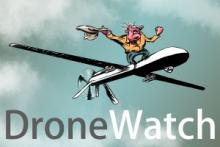
The Bureau of Investigative Journalism has released its monthly report on covert actions in Pakistan, Yemen, and Somalia.
Pakistan: August sees the highest number of CIA strikes in Pakistan since October 2011. A number of senior militants are killed along with at least two named civilians.
July 2012 actions
Total CIA strikes in August: 7
Total killed in strikes in August: 29-65, of whom at least 2 were reportedly civilians
For the Bureau’s full Pakistan databases click here.
Yemen: At least 26 people are killed in five confirmed US drone strikes in Yemen. This is still less than the May peak. Civilian casualties are confirmed for the first time since May.
August 2012 actions
Confirmed US drone strikes: 5
Further reported/possible US strike events: 1
Total reported killed in US operations: 26-33
Civilians reported killed in US strikes: 2
Click here for the full Yemen data.
Somalia: For the fourth month no US military actions are reported in Somalia.
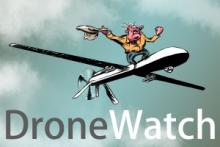
U.S. drones are having a busy weekend, killing people in both Pakistan and Yemen.
On Saturday, an attack in Pakistan is reported to have killed six people. Pakistan’s The Nation reports that “A U.S. drone strike targeting a compound on Saturday killed at least six suspected militants in North Waziristan’s Datta Khel tehsil bordering Afghanistan.” DAWN newspaper added that “six drones flying low in Dattakhel fired four rockets on a vehicle and a house.”
On Sunday, AP reported a strike in Yemen killed five people, including a top al-Qaida militant wanted for allegedly masterminding a 2002 attack on a French oil tanker.
In a separate attack, 14 civilians were killed when a disputed strike hit two cars. In the same story, AP reported:
“Yemeni fighter planes mistakenly hit vehicles carrying civilians traveling south of the capital, killing 14. Military officials said the airstrikes in Radda in the province of Bayda were based on faulty intelligence that the passengers were al-Qaida members. Missiles fired from the warplanes hit two vehicles carrying local residents returning to their villages. Tribesman Sheik Ahmed Ali said the dead included three women and three children.”
The Yemen Post, however, cites “local sources” saying the attack was by a U.S, drone. Al Jazeera, citing officials and local tribal leaders, also reported the attack as a drone strike. Bloomberg, citing an “independent Yemeni news website,” reported that “it wasn’t clear whether the strike was launched from a U.S. drone or a Yemeni warplane.”
Either way, 14 civilians are dead due to faulty intelligence. Ultimately, that is more important than the source of the missiles that killed them.
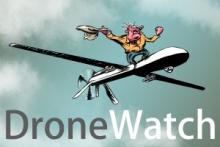
Last week was drone week in Pakistan, this week it’s Yemen. Two deaths were reported in an attack on a car on Tuesday, at least four in another car on Wednesday, and another attack today that killed eight. Reuters reports:
“Eight Islamist militants were killed by a U.S. drone strike on Friday in a remote part of Hadramout, a Yemeni official said, the third such strike in the eastern Yemeni province this week.
Yemen's defense ministry said on its website that eight al Qaeda members were killed in an air strike on their vehicle in the isolated, desert district of Hawra. The local official, who declined to be named, said it was a drone strike.
The men were heavily armed, carrying machine-guns and explosives, the ministry said. The local official said the men were thought to have been on the way to carry out an attack.”
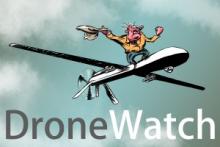
Reuters reports that a drone attack in central Yemen yesterday killed two suspected militants:
"Two men thought to be Islamist militants were killed in an apparent U.S. drone attack on a car in central Yemen on Tuesday, the defense ministry said.
A security source and witnesses told Reuters the car was hit on a remote road from Hadramout to Maareb province - a mostly desert southeastern region where militants have taken refuge after being driven from their southern strongholds last month.
It was not clear if there were other casualties in the attack. Washington, which fears the spread of militants in Yemen, has stepped up attacks by unmanned drones this year."
The Yemen Post reported a local website as quoting a security source saying that one of those killed was a Saudi militant, and that a second car managed to get away.
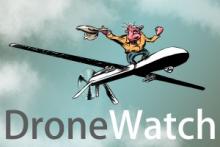
In a speech yesterday in Washington, administration counter-terrorism advisor John Brennan defended the campaign of drone strikes in Yemen. As reported in the Los Angeles Times:
“In his most explicit comments on Washington's largely hidden military and intelligence operations in Yemen, John Brennan said no evidence indicates that the drone strikes are helping recruit members for Al Qaeda in the Arabian Peninsula, or AQAP, the Yemen-based group that is Al Qaeda's most active branch. ...
"Brennan said that the drone pilots, who operate the aircraft from remote ground stations, make every effort to avoid civilian casualties. 'And contrary to conventional wisdom, we see little evidence that these actions are generating widespread anti-American sentiment or recruits for AQAP. ... In short, targeted strikes against the most senior and most dangerous AQAP terrorists are not the problem, they are part of the solution.' "
Addressing a common concern, Brennan said that the only targets for drones are militants whose goal is to attack the US or its allies, not those fighting against the Yemeni government. He added that U.S. officials do provide intelligence information to Yemeni armed forces fighting against militants.
The report noted that the drone attacks are part of a larger strategy.
“U.S. special operations forces have been advising Yemeni military units, and Washington is providing $337 million in aid to Yemen this year, the largest American aid package ever disbursed to the impoverished nation.”
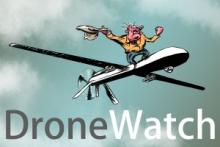
According to the Associated Press, over the past two days, in two separate strikes, U.S. drones killed 10 al-Qaida militants in Yemen.
The first attack late Monday hit two vehicles carrying seven passengers in the southern town of Radda, killing them all. Another U.S. drone targeted a second vehicle on Tuesday carrying three militants in the Zoukaika region of Hadramawt. One of the dead was identified as Abdullah Awad al-Masri, described as one of the "most dangerous elements" of al-Qaida in the militant stronghold of Bayda province and the man in charge of a bomb-making lab.

The Long War Journal, citing AFP, reports that the first known U.S. drone strike in Yemen in more than a month took place Saturday:
“The U.S. killed five al Qaeda in the Arabian Peninsula fighters in a drone airstrike in eastern Yemen. The strike is the first in Yemen in more than a month.
The unmanned Predators or Reapers fired a pair of missiles at a vehicle in Al Qotn in Hadramout province earlier today, AFP reported. Five AQAP fighters were killed in the strike.
No senior AQAP leaders or operatives are reported to have been killed in the strike. The identities of those killed have not been disclosed.”
The Associated Press reports a drone strike in Yemen earlier today:
"A Yemeni official says a suspected U.S. drone strike has killed two al-Qaida militants in a car in Yemen's south. Tribal officials there said four militants were killed."
One of the most respected sources of investigative reporting on drones is The Bureau of Investigative Journalism, a non-profit organization based in London. As part of  its research, TBIJ tracks drone strikes and other US military and paramilitary actions in Yemen, Somalia and Pakistan. Yesterday, TBIJ released its summary for June. The major conclusions:
its research, TBIJ tracks drone strikes and other US military and paramilitary actions in Yemen, Somalia and Pakistan. Yesterday, TBIJ released its summary for June. The major conclusions:
- As relations between Washington and Islamabad continue to falter, Bureau data shows fewer civilians are being killed in CIA drone strikes in Pakistan than at any time in the Obama presidency.
- US military action in Yemen is at its bloodiest ever, with the strike rate and reported casualties the highest yet recorded.
- The true extent of US action in Somalia remain unclear, despite many claims of attacks.
The report also provides a comparison of the first six months of this year with 2011.
The Associated Press reports: 
"The White House’s semiannual report to Congress on the state of U.S. combat operations abroad, delivered Friday, mentions what has been widely reported for years but never formally acknowledged by the administration: The U.S. military has been taking “direct action” against members of al-Qaida and affiliates in Yemen and Somalia.
The report does not elaborate, but “direct action” is a military term of art that refers to a range of lethal attacks, which in the case of Yemen and Somalia include attacks by armed drones. … The report applies only to U.S. military operations, including those by special operations forces — not those conducted by the CIA."
Another step toward greater transparency, which can hopefully lead to greater accountability.
Ibrahim Mothana, an activist, writer and community worker from Yemen, writes that the anger and despair resulting from civilian casualties of drone strikes are causing  Yemenis to join radical militants:
Yemenis to join radical militants:
"Anti-Americanism is far less prevalent in Yemen than in Pakistan. But rather than winning the hearts and minds of Yemeni civilians, America is alienating them by killing their relatives and friends. Indeed, the drone program is leading to the Talibanization of vast tribal areas and the radicalization of people who could otherwise be America’s allies in the fight against terrorism in Yemen. … Yemeni tribes are generally quite pragmatic and are by no means a default option for radical religious groups seeking a safe haven. However, the increasing civilian toll of drone strikes is turning the apathy of tribal factions into anger. The strikes have created an opportunity for terrorist groups like Al Qaeda in the Arabian Peninsula and Ansar al-Sharia to recruit fighters from tribes who have suffered casualties."
After more than a week with no reported drone strikes, there are news reports this morning of strikes in Yemen and Pakistan.
Over the past several days, the Yemeni army has recaptured two towns from Ansar al-Sharia — an offshoot of al-Qaeda in the Arabian Peninsula. Militants have fled and heavy fighting continues. Apparently as part of that offensive, an attack by a US drone killed nine people:
“A US drone struck a house where al-Qaeda militants were meeting, and a car nearby," in the town of Azzan in Shabwa province early in the morning, a tribal source told AFP on condition of anonymity.
In Pakistan, the Associated Press reports:
"Pakistani intelligence officials say a U.S. drone strike has killed four suspected militants after firing two missiles at a vehicle in which they were riding near the Afghan border.
The escalating campaign of drone attacks in Yemen is having the opposite effect from what the U.S. intends:
"Across the vast, rugged terrain of southern Yemen, an escalating campaign of U.S. drone strikes is stirring increasing sympathy for al-Qaeda-linked militants and driving tribesmen to join a network linked to terrorist plots against the United States. After recent U.S. missile strikes, mostly from unmanned aircraft, the Yemeni government and the United States have reported that the attacks killed only suspected al-Qaeda members. But civilians have also died in the attacks, said tribal leaders, victims’ relatives and human rights activists."
 Who is targeted for killing in U.S. drone strikes? Counterterrorism adviser John Brennan claimed in his recent speech that:
Who is targeted for killing in U.S. drone strikes? Counterterrorism adviser John Brennan claimed in his recent speech that:
"when considering lethal force we ask ourselves whether the individual poses a significant threat to U.S. interests. This is absolutely critical, and it goes to the very essence of why we take this kind of exceptional action. …We are not seeking vengeance, rather we conduct targeted strikes because they are necessary to mitigate an actual ongoing threat, to stop plots, prevent future attacks and save American lives."
But Greg Miller reported Sunday in The Washington Post
"The quickening pace of the U.S. drone campaign in Yemen this year has raised new questions about who is being targeted and why. A review of strikes there so far suggests that the Obama administration has embraced a broader definition of what constitutes a terrorism threat that warrants a lethal response.
In more than 20 U.S. airstrikes over a span of five months, three “high-value” terrorism targets have been killed, U.S. officials said. A growing number of attacks have been aimed at lower-level figures who are suspected of having links to terrorism operatives but are seen mainly as leaders of factions focused on gaining territory in Yemen’s internal struggle."
A former high-ranking counterterrorism official said that targets must still be a “direct threat” to U.S. interests. “But the elasticity of that has grown over time,” he added.

Last month, White House counter-terrorism adviser John Brennan acknowledged in a public speech at the Woodrow Wilson Center that the United States was using armed unmanned drones to kill alleged militants.
Brennan’s acknowledgement was the only “new” news.
Beginning in earnest under President George W. Bush and dramatically escalating under President Barack Obama, the United States is now using drones in four countries (Afghanistan, Pakistan, Yemen, and Somalia), and has used them in two others (Iraq and Libya). Going by the names Reaper and Predator, firing missiles named Hellfire, the drones are responsible for thousands of deaths, including hundreds of women and children.
Why drones?
There are three major reasons opponents of the unmanned death planes usually give. First, in fighting against terrorist and insurgent organizations, the United States has adopted a kill — not capture — strategy. With a “kill list” of targets, the attacks aim at known or suspected leaders.
Second, the attacks can be carried out with no danger to American troops. Remotely guided from distant locations, drones are a way of carrying out risk-free military operations. Third, with the attacks increasingly under the control of the CIA rather than the military, they can be conducted with a high degree of secrecy. Whom the drones targeted and killed, and how many civilians may have also been killed, is free of scrutiny.
It seems that drones have become the administration’s favorite form of warfare. There’s no danger to American troops, just unmanned aircraft killing from the skies. They’ve been used in Iraq, Afghanistan, Pakistan, Somalia, Libya, and Yemen.
The campaign in Yemen has so far relied on targeting specific individuals in an attempt to distinguish between al Qaeda leaders and Yemeni insurgents. But the CIA is now seeking to expand the campaign by asking for authority to launch strikes without knowing the identities of those being attacked. They call it “signature strikes,” choosing targets based on suspicious behavior. This, the CIA claims, involved putting together multiple intelligence reports to arrive at “signatures” of al-Qaeda activity based on vehicles, facilities, communications equipment and patterns of behavior.
Assassinating specific individuals (and often their wives, children and other people who happen to be with them) is bad enough. Attacks based on “signatures” of suspicious behavior is worse. Is a group of people gathering in a house an al Qaeda meeting, or a wedding? Is a truck convoy carrying weapons, or goods to market? It seems to me that if approved, it’s a policy change that will result in more civilian casualties and more questions about the use of drones.
Duane Shank is Senior Policy Advisor at Sojourners. You can follow him on Twitter @DShankDC.
An activist in Phoenix launches a website -- and supports a revolution on the other side of the world.